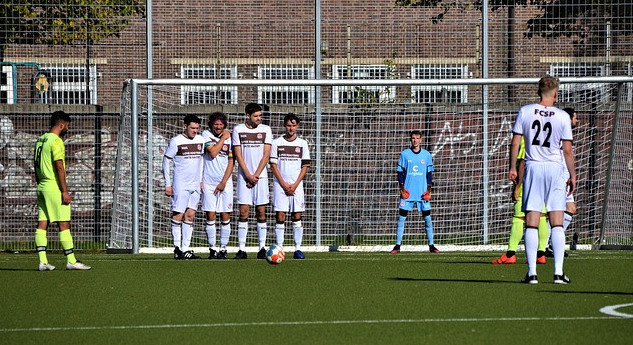Set pieces in soccer play a crucial role in determining the outcome of a match.
Imagine a soccer match hanging in the balance, tied at one goal each. The clock ticks down, tension thick in the air as players take their positions for a corner kick.
The stadium roars, knowing that this set piece could determine the game’s outcome. In the world of soccer, these set-piece moments are akin to a canvas waiting for a masterstroke.
Introduction
Set pieces are the hidden gems that can turn a match on its head, and understanding their importance is like holding a key to unlocking victory.
From free kicks and corners to throw-ins and penalty kicks, these moments present unique opportunities for teams to capitalise on their opponent’s weaknesses and secure vital goals.
As a coach or player, understanding the significance of set pieces and implementing effective training methods can give your team a strategic edge and boost their chances of success.
In this article, we will delve into the importance of set pieces and explore practical ways to train for these decisive moments.

The Significance of Set Pieces
Set pieces are critical turning points in soccer matches. While open play relies on continuous fluidity and improvisation, set pieces provide structured situations where teams can plan, practice, and execute specific strategies.
Here’s why set pieces are so significant:
The Significance of Set PiecesSet pieces in soccer have a magical quality – they are the instances when a game slows down just a fraction, allowing for strategic choreography amid the chaos.
These moments offer teams the chance to orchestrate their moves with precision and intent, often leading to breathtaking goals or game-saving clearances. But why are these set pieces so significant?
1. Goal-Scoring Opportunities
When the ball rests still, waiting for the perfect kick to awaken it, goal-scoring opportunities become tangible dreams.
Set pieces provide the chance to position attackers in ways that exploit defensive gaps, turning hopes into goals and games into triumphs.
2. Leveling the Playing Field
In soccer, as in life, there are underdogs – teams facing seemingly insurmountable odds. Set pieces, however, are the equalisers, the moments when a well-drilled routine can dismantle even the most formidable defence.
It’s not just about skill; it’s about strategy and seizing the opportune instant.
3. Defensive Prowess
Set pieces aren’t solely offensive tools; they are defensive shields as well. A resolute defence during these moments can thwart opponents’ aspirations and bolster a team’s resilience.
The ability to stand firm and repel threats is as much an art as orchestrating an attack.
4. Psychological Impact
There’s an air of vulnerability during set pieces, a heightened anticipation that electrifies the field. Scoring from a perfectly executed set piece doesn’t just notch up the scoreboard; it imprints doubt on the minds of adversaries.
Conversely, defending with valour can invigorate a team, fostering the belief that no situation is insurmountable.
A Famous Corner Kick: When Precision Meets Passion
In the annals of soccer history, one anecdote stands as a testament to the power of set pieces.
In the dying moments of the 1999 UEFA Champions League final, Bayern Munich led Manchester United 1-0. With seconds left, Manchester United won a corner kick – a final opportunity to defy the odds.
As the ball soared into the box, chaos erupted, and amidst the frenzy, Teddy Sheringham nudged it to Ryan Giggs, who, with uncanny composure, set up Ole Gunnar Solskjær.
In a crescendo of precision and passion, Solskjær’s shot found the back of the net, sealing an improbable victory.
This moment etched the indelible truth that set pieces are not just tactical manoeuvres; they are the embodiment of a team’s collective spirit and unwavering determination.

Types of Set Pieces
Before we delve into the art of training set pieces, let’s briefly explore the array of scenarios that fall under this umbrella:
1. Free Kicks
From the precise swerve of a direct free kick to the intricate choreography of an indirect one, free kicks are canvases for the virtuosos of the sport. They encapsulate strategy, power, and finesse, offering an unscripted symphony of possibilities.
2. Corner Kicks
Corner kicks are akin to setting the stage for a grand performance. They bring together attackers in a ballet of runs and defenders in a fortress of anticipation. A well-placed corner kick is like delivering an invitation to a dance where only the ball knows the next move.

3. Throw-Ins
Throw-ins, often considered mundane, possess hidden potential. Like a playwright crafting a plot twist, a well-practised throw-in routine can catch opponents off-guard, shifting the narrative of a match in an instant.
4. Penalty Kicks
The solitary drama of a penalty kick epitomizes pressure. It’s a moment where two adversaries stand face-to-face, skill against intuition, nerves against preparation. Here, the mind games of both taker and keeper intersect with raw skill, creating a microcosm of soccer’s essence.
Training Methods for Set Pieces
To harness the potency of set pieces, rigorous training is non-negotiable. Here are some methods to sculpt your team into set-piece maestros:
1. Practice with Purpose
Set-piece training is more than just routine; it’s a purposeful endeavour. Analyse your team’s strengths and opponents’ weaknesses, and sculpt your training accordingly. Every player should grasp their role and responsibilities, making every move purposeful.
2. Repetition and Variation
Set pieces thrive on precision, which is a product of repetition. Players must practice each set piece until it becomes muscle memory. Yet, do not be bound by rigidity; infuse variations to keep opponents guessing and maintain a sense of spontaneity.

3. Simulate Match Conditions
Match day is the grand stage, and training is the rehearsal. Simulate match conditions during training to accustom players to pressure, noise, and intensity. Train their minds to thrive amid chaos, making the real performance feel like second nature.
4. Involve the Whole Team
Set pieces aren’t a solo act; they’re a symphony. Involve every player, not just those directly engaged in the play. Defenders must understand how to clear the ball, midfielders should know how to transition, and attackers need to anticipate rebounds.
5. Analyse and Learn from Others
The soccer world is brimming with experts. Study successful teams and players celebrated for their set-piece prowess. Immerse yourself in their strategies, adapting and evolving them to weave your team’s unique story.
6. Encourage Creativity
The structure is the skeleton of set pieces, but creativity breathes life into them. Encourage players to think outside the playbook, to innovate in the heat of the moment. It’s in these sparks of brilliance that matches are transformed.
Conclusion: Your Team’s Symphony Awaits
The allure of set pieces lies in their potential – the potential to alter destinies, to etch stories, and to craft triumphs. These are the moments where soccer transcends the field, becoming a theatre of strategy, athleticism, and sheer will.
As a coach or player, you hold the baton; you conduct the symphony. So, embark on this journey with renewed zeal. Train your team to embrace the nuances of set pieces, infuse them with strategy, and execute them with finesse.
Unleash the creativity, choreograph the movements, and, above all, nurture the passion. For on the field, amidst the cheers and echoes of history, your team’s set pieces can become the crescendos that define a legacy.
It’s time to turn the canvas of a set piece into a masterpiece that will be remembered for years to come.


